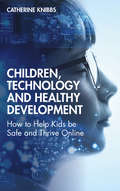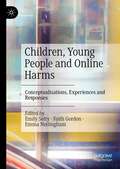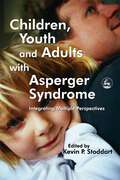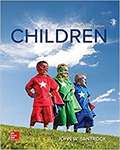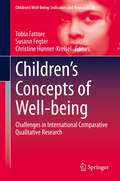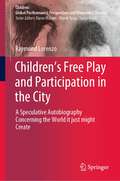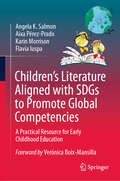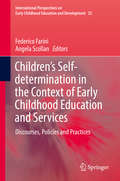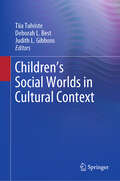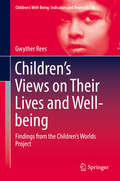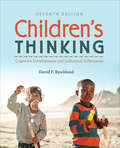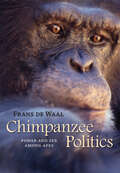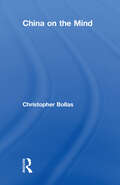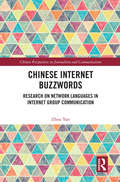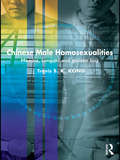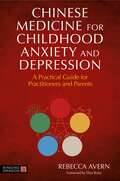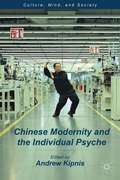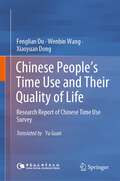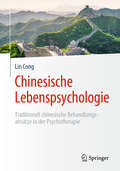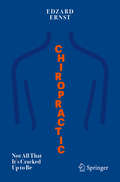- Table View
- List View
Children, Technology and Healthy Development: How to help kids be safe and thrive online
by Catherine KnibbsHow can adults keep children safe and healthy online now and in the future? How can we thrive alongside technology? This highly accessible book unpacks the latest psychological research, attachment theory and neurobiology to offer parents and professionals insight into how technology impacts children’s development, and how to navigate our lives online. Cath Knibbs shares her extensive experience to reveal what we know about human behaviour in cyberspace, and particularly that of children using devices, consoles and social media platforms. She offers deeper understanding of how and why children engage online and shows parents and professionals how, rather than being overwhelmed by the dangers and pathologies of cyberspace, we can learn to support children in using technology healthily. She covers key topics including social media use and abuse, impact of screen time, issues around gaming, and extreme behaviours online. By the end of this book you will be able to understand your child better, and have an understanding of what is happening in their minds, brains and bodies in relation to the technological and digital world. Children, Technology and Healthy Development is for all parents, and professionals in psychology, education, social care and the police who are concerned with understanding how we support children in an online world. It will also be valuable reading for those in tech design interested in the impact of technology on the developing human.
Children, Young People and Online Harms: Conceptualisations, Experiences and Responses
by Faith Gordon Emily Setty Emma NottinghamThis book presents research conducted with children and young people about online harms, with a UK focus, while aiming to stimulate comparative analyses of other countries too. While the chapters vary in how data-driven they are, each will explore conceptualisations of online harm, children and young people’s experiences of online harms, and their perspectives on interventions to educate about and address online harms. While the UK government claimed in 2019 to be introducing ‘tough new measures to make the UK the safest place to be online’, it has been noted that there may be a limited capacity for formal legislation to address the complexities of contemporary digital life for children and young people; instead, tackling online harms has to be part of a broader agenda and must account for the diverse and socially contingent nature of children's and young people’s experiences online, as evidenced by extensive research undertaken with children and young people. With the finalisation of legislation surrounding online harms in the UK imminent, the objective of this collection is to shape the implementation of policy in practice settings. To support practice development, the book offers vignette-style pieces that will describe examples of policy and practice models and how these models can support children's and young people’s active participation in understanding online harms. As a result of this, the findings of this book will minimise the disparity between the practice, policy and research through speaking to the interface between these fields in the UK context. young people. Taking the UK as its focus, this edited collection will present research conducted with children and young people. Taking the UK as its focus, this edited collection will present research conducted with children and young people. Taking the UK as its focus, this edited collection will present research conducted with children and youngpeople. Taking the UK as its focus, this edited collection will present research conducted with children and young people. Taking the UK as its focus, this edited collection will present research conducted with children and young people. Taking the UK as its focus, this edited collection will present research conducted with children and young people. Taking the UK as its focus, this edited collection will present research conducted with children and young people. Taking the UK as its focus, this edited collection will present research conducted with children and young people. Taking the UK as its focus, this edited collection will present research conducted with children and young people. Taking the UK as its focus, this edited collection will present research conducted with children and
Children, Youth and Adults with Asperger Syndrome: Integrating Multiple Perspectives
by Kevin StoddartThis book offers a comprehensive overview of clinical, research and personal perspectives on Asperger Syndrome, including contributions from parents and experts in the fields of psychology, social work, psychiatry, genetics, sexology and vocational counselling. It includes first-hand accounts from adults with AS, highlighting their difficulties in areas such as social competence and education. Specialist perspectives on AS, including sexuality and relationships, finding and keeping employment and anxiety and depression are sensitively addressed. The viewpoints of parents explore experiences of parenting AS individuals. These varied approaches to living with AS complement the emerging literature on theory, research and practice in this area. The broad scope of Children, Youth and Adults with Asperger Syndrome guarantees a wide readership among practitioners, students, parents, young people and adults with AS, educates service providers how to assist people with AS and suggests a model of interdisciplinary collaboration for administrators and funders.
Children: Fourteenth Edition
by John W. SantrockConnecting research and results. As a master teacher John Santrock connects students to current research and real-world application, helping students see how developmental psychology plays a role in their own lives and future careers. Through an integrated, personalized digital learning program, students gain the insight they need to study smarter and improve performance.
Children’s Concepts of Well-being: Challenges in International Comparative Qualitative Research (Children’s Well-Being: Indicators and Research #24)
by Susann Fegter Christine Hunner-Kreisel Tobia FattoreThis book presents a range of innovative analytical frameworks that can be used to approach the complexities of children’s understandings and experiences of well-being in a locally oriented, context-sensitive and multi-nationally comparative way. It addresses the challenges of undertaking research on children’s understandings of well-being from a multi-national qualitative perspective. Chapters in the book present results that show how children from various places all over the world conceptualize and experience well-being as well as how this is linked local, regional and national social, political and cultural contexts.
Children’s Discovery of the Active Mind: Phenomenological Awareness, Social Experience, and Knowledge About Cognition (SpringerBriefs in Psychology)
by Bradford H. PillowDuring the past 25 years, a great deal of research and theory has addressed the development of young children's understanding of mental states such as knowledge, beliefs, desires, intentions, and emotions. Although developments in children's understanding of the mind subsequent to early childhood has received less attention, in recent years a growing body of research has emerged examining understanding of psychological functioning during middle and late childhood. Combined with the literature on adolescent epistemological development, this research provides a broader picture of age-related changes in children's understanding of the mind. Guided by the goals of describing developmental changes in children's concepts of cognitive functioning and identifying sources of information that contribute to learning about cognition, Children's Discovery of the Active Mind organizes empirical literature concerning the development of children's knowledge of cognitive activities from early childhood to adolescence and presents a conceptual framework that integrates children's introspective activities with social influences on development. Bringing together theoretical and empirical work from developmental, cognitive, and social psychology, the author argues that rather than depending upon a single source of information, developmental progress is driven by combinations of children's conceptual knowledge of mental functioning, children's phenomenological awareness of their own cognitive activities, and children's social experience.
Children’s English in Singapore: Acquisition, Properties, and Use (Routledge Studies in World Englishes)
by Sarah BuschfeldCombining the World Englishes framework with First Language Acquisition methodology, this book investigates children’s acquisition of L1 English in the context of multilingual Singapore, one of the traditional Kachruvian Outer Circle or ESL countries. The book investigates language choice, use, and dominance in Singaporean families, identifies common linguistic characteristics of L1 Singapore English, as well as the acquisitional route that Singaporean children take. It discusses characteristics at the different levels of language organization, i.e., phonological, morphosyntactic, lexical, and pragmatic features, drawing on a variety of systematically elicited data and Praat-based acoustic analyses. Comparing the results to similar data obtained from children living in England (both mono- and bi-/multilingual), the book also sheds light on how the acquisitional steps taken by Singaporean children differ from or are similar to traditional native speakers of English and children from immigrant families in England.
Children’s Free Play and Participation in the City: A Speculative Autobiography Concerning the World it just might Create (Children: Global Posthumanist Perspectives and Materialist Theories)
by Raymond LorenzoThis book presents an interplay of imaginative memoir-telling, action research data and future projection that reminds and inspires experiences academics, researchers, professionals, as well as a wider public to recognize the fundamental importance and the impellent need for more and better work in favour of true political and societal recognition of the needs and rights of children to play freely, to participate, to live fully and enjoy their neighbourhoods and cities, and to imagine and construct alternative futures, together with adults. The book's abundant spoken dialogue is, in effect, storytelling between children (and youth) on their own and with adults (especially the elderly). It conveys an appreciation of children’s special capacities to think critically about their everyday places—and the greater world around them—and to develop solutions (or ‘projects’) for the problems they identify. This book serves an effective catalyst for stimulating rich discussion of the theoretical and practical bases of the many themes, or areas of study, which are treated in the story.
Children’s Literature Aligned with SDGs to Promote Global Competencies: A Practical Resource for Early Childhood Education
by Karin Morrison Angela K. Salmon Aixa Pérez-Prado Flavia IuspaThis book presents children’s literature as a platform for learning and helping young readers develop the knowledge, skills, and attitudes needed to thrive in an interconnected and diverse global society. It draws from various theoretical frameworks and research findings to implement critical literacy and culturally responsive teaching in the meaning-making process.The book focuses on global competencies and Sustainable Development Goals (SDGs) as intertwined concepts that work together to foster a more sustainable, inclusive, and equitable world. Developing global competencies empowers children and communities to actively participate in achieving the SDGs and addressing the pressing challenges of our time. The authors set high expectations on children as actors in transforming society. To facilitate this, the book offers an overview of child development theories as a foundation for designing developmentally appropriate practices to extend children’s books toward deep thinking and understanding. The book includes sample lessons that use cutting-edge research-based pedagogies and tools such as visible thinking routines and other approaches. Those lessons also help readers identify the Habits of Mind (HOM) children can develop by listening to and discussing stories. The HOM are attributes of good problem-finders and problem-solvers needed when confronting complex issues. The book provides resources and sample lessons that implement different thinking strategies to engage children in questioning and analyzing what they read, making them more critical. This is how children deeply understand the world and their role in creating positive change. The book aims to cultivate change-makers and global citizens through stories. It offers innovative approaches, including online learning options in accessible and engaging ways to help children think globally and act locally‘Through the power of children’s literature, this book serves a larger agenda: To build a more thoughtful world for future generations. By caring for and learning from one another through suggested activities in this book, they will share the riches and resources from across the world. As children learn about the promise of actions toward the UN Sustainable Goals, they can imagine living in an interdependent learning community where all people continually searching for ways to trust each other, learn together, and grow toward greater intelligence.’ Arthur Costa and Bena Kallick, Co-Founders and Directors of The Institute for Habits of Mind
Children’s Self-determination in the Context of Early Childhood Education and Services: Discourses, Policies and Practices (International Perspectives on Early Childhood Education and Development #25)
by Federico Farini Angela ScollanThis book investigates the position of young children’s self-determination within a range of social contexts, such as education, social care, mass-media, health, politics, law and the family. It brings to the fore the voices of the children in the present, with their interests, agendas and rights. Based on original primary research, the chapters tackle hegemonic discourses on children’s self-determination as well as current policies and practices. They address a broad range of topics, from the planning of role-play to national policies, from the use of digital technologies for pedagogy to children’s health and well-being, and from democratic practices in the classroom to the preservation of traditional family values. The book presents case studies to unravel how childhood and young children’s self-determination are constructed at the intersection with intergenerational relationships. Coming from different disciplines and using a diverse range of methodological traditions, the contributions in the volume eventually converge to generate a rich, complex and multi-layered analysis of contemporary cultures of childhood and young children’s rights.
Children’s Social Worlds in Cultural Context
by Judith L. Gibbons Tiia Tulviste Deborah L. BestThis book addresses cultural variability in children’s social worlds, examining the acquisition, development, and use of culturally relevant social competencies valued in diverse cultural contexts. It discusses the different aspects of preschoolers’ social competencies that allow children – including adopted, immigrant, or at-risk children – to create and maintain relationships, communicate, and to get along with other people at home, in daycare or school, and other situations. Chapters explore how children’s social competencies reflect the features of the social worlds in which they live and grow. In addition, chapters examine the extent that different cultural value orientations manifest in children’s social functioning and escribes how parents in autonomy-oriented cultures tend to value different social skills than parents with relatedness or autonomous-relatedness orientations. The book concludes with recommendations for future research directions. Topics featured in this book include:Gender development in young children.Peer interactions and relationships during the preschool years.Sibling interactions in western and non-western cultural groups.The roles of grandparents in child development.Socialization and development in refugee children.Child development within institutional care. Children’s Social Worlds in Cultural Context is a valuable resource for researchers, clinicians/practitioners, and graduate students in developmental psychology, child and school psychology, social work, cultural anthropology, family studies, and education.
Children’s Views on Their Lives and Well-being: Findings from the Children’s Worlds Project (Children’s Well-Being: Indicators and Research #18)
by Gwyther ReesThis book presents a comprehensive overview of findings from the Children's Worlds project - the most extensive and diverse study to have been conducted globally on children's own views of their lives. It provides a unique comparative insight into the similarities and differences in children's lives and well-being around the world, including findings that challenge prevailing assumptions of where, and in what contexts, children might experience a 'good childhood'. The book draws out the key messages and implications from the study and identifies directions for future work on child well-being. It will be of interest to researchers and students in the field of childhood studies, as well as a wide range of professionals and organisations concerned with improving children's quality of life.
Children′s Thinking: Cognitive Development and Individual Differences
by David F. BjorklundChildren’s Thinking: Cognitive Development and Individual Differences, Seventh Edition by David Bjorklund remains the most comprehensive and current topical textbook available in cognitive development. The text presents up-to-date, thorough research studies and data throughout. Bjorklund expertly introduce readers to the concept of developmental function, which explains that healthy children can individually vary in their cognition as they develop. This concept is discussed throughout the text within the context of the typical progression of cognitive development through infancy and childhood. In addition, the text includes framework showing that, although some traits are established at birth, children’s cognitive development is also shaped by the physical and social environments that surround them throughout their formative years. The seventh edition has been updated to include current and extensive research, sociocultural coverage, evolutionary coverage of memory development, children’s development of prosocial cognition, moral development, and the concept of overimitation.
Children′s Thinking: Cognitive Development and Individual Differences
by David F. BjorklundChildren’s Thinking: Cognitive Development and Individual Differences, Seventh Edition by David Bjorklund remains the most comprehensive and current topical textbook available in cognitive development. The text presents up-to-date, thorough research studies and data throughout. Bjorklund expertly introduce readers to the concept of developmental function, which explains that healthy children can individually vary in their cognition as they develop. This concept is discussed throughout the text within the context of the typical progression of cognitive development through infancy and childhood. In addition, the text includes framework showing that, although some traits are established at birth, children’s cognitive development is also shaped by the physical and social environments that surround them throughout their formative years. The seventh edition has been updated to include current and extensive research, sociocultural coverage, evolutionary coverage of memory development, children’s development of prosocial cognition, moral development, and the concept of overimitation.
Chimpanzee Politics: Power and Sex among Apes
by Frans de WaalThe first edition of Frans de Waal's Chimpanzee Politics was acclaimed not only by primatologists for its scientific achievement but also by politicians, business leaders, and social psychologists for its remarkable insights into the most basic human needs and behaviors. Still considered a classic, this updated edition is a detailed and thoroughly engrossing account of rivalries and coalitions—actions governed by intelligence rather than instinct. As we watch the chimpanzees of Arnhem behave in ways we recognize from Machiavelli (and from the nightly news), de Waal reminds us again that the roots of politics are older than humanity.
China on the Mind
by Christopher BollasSeveral thousand years ago Indo-European culture diverged into two ways of thinking; one went West, the other East. Tracing their differences, Christopher Bollas examines how these mentalities are now converging once again, notably in the practice of psychoanalysis. Creating a freely associated comparison between western psychoanalysts and eastern philosophers, Bollas demonstrates how the Eastern use of poetry evolved as a collective way to house the individual self. On one hand he links this tradition to the psychoanalytic praxes of Winnicott and Khan, which he relates to Daoism in their privileging of solitude and non verbal forms of communicating. On the other, Bollas examines how Jung, Bion and Rosenfeld, assimilate the Confucian ethic that sees the individual and group mind as a collective, while Freudian psychoanalysis he argues has provided an unconscious meeting place of both viewpoints. Bollas’s intriguing book will be of interest to psychotherapists, psychoanalysts, Orientalists, and those concerned with cultural studies.
Chinese International Students’ Stressors and Coping Strategies in the United States (Education in the Asia-Pacific Region: Issues, Concerns and Prospects #37)
by Kun YanThis book explores how Chinese students abroad may suffer stress, and how they conceptualize and adapt to stress in the American higher education environment. To do so, it adopts a mixed methods design: the sequential explanatory design, which is characterized by the collection and analysis of quantitative data followed by the collection and analysis of qualitative data. To date, no empirical research has focused solely upon understanding the stress and coping processes of Chinese students in the United States. This book addresses that gap, enriching the body of literature on international students' adaptation process in foreign countries.
Chinese Internet Buzzwords: Research on Network Languages in Internet Group Communication (Chinese Perspectives on Journalism and Communication)
by Zhou YanAs the Internet has reshaped the way we communicate, people’s reading has become more fragmented and attention has been directed to a more concise and general form of language that outlines the most important information. This language of the internet, a language system that concentrates on the content of events and public emotions, has emerged and received wide currency. This monograph is one of the first books to examine the language of the internet in the Chinese context. By analysing content and discourse, the author examines Chinese website buzzwords since 2010. She reveals the mechanisms of generation, the cultural nature and political characteristics of the network language, analyzes the causes of its emergence and popularity, and highlights its social and academic significance. Meanwhile, she argues that research in the area is essentially interdisciplinary, involving not only perspectives from Journalism and Communication Studies, but also Philosophy, Culture, Linguistics and Sociology. Students and scholars of Communication Studies and Journalism, as well as Culture Studies should be greatly interested in this title.
Chinese Male Homosexualities: Memba, Tongzhi and Golden Boy (Routledge Contemporary China Series)
by Travis S. KongThis book presents a groundbreaking exploration of masculinities and homosexualities amongst Chinese gay men. It provides a sociological account of masculinity, desire, sexuality, identity and citizenship in contemporary Chinese societies, and within the constellation of global culture. Kong reports the results of an extensive ethnographic study of contemporary Chinese gay men in a wide range of different locations including mainland China, Hong Kong and the Chinese overseas community in London, showing how Chinese gay men live their everyday lives. Relating Chinese male homosexuality to the extensive social and cultural theories on gender, sexuality and the body, postcolonialism and globalisation, the book examines the idea of queer space and numerous 'queer flows' – of capital, bodies, ideas, images, and commodities – around the world. The book concludes that different gay male identities – such as the conspicuously consuming memba in Hong Kong, the urban tongzhi, the 'money boy' in China and the feminised 'golden boy' in London – emerge in different locations, and are all caught up in the transnational flow of queer cultures which are at once local and global.
Chinese Medicine for Childhood Anxiety and Depression: A Practical Guide for Practitioners and Parents
by Rebecca AvernTackling mental-emotional health problems in young people from a Chinese medicine perspective, this book shows how a child's mental-emotional health is intrinsically connected with core elements of their everyday life. It suggests an approach to preventing and healing anxiety and depression that involves neither medication nor costs anything.Part One of the book explains Chinese medicine concepts related to mental-emotional health in a way that is accessible for those with no prior knowledge. It includes chapters on how to recognise a child's Five Element imbalance and how children of each element type need a different kind of nurture and lifestyle in order to remain mentally-emotionally healthy. Each chapter in Part Two examines a particular pillar of mental-emotional health such as connection, family life, emotions, and diet through a Chinese medicine lens. Each chapter is full of practical tips. Throughout, there is an emphasis on guiding parents and practitioners to discern what is right for a particular child, and that each child will need something different.Addressing childhood anxiety and depression using a unique, accessible, and practical perspective, Chinese Medicine for Childhood Anxiety and Depression is an invaluable book for practitioners and parents alike.
Chinese Modernity and the Individual Psyche
by Andrew B. KipnisRapid industrialization, urbanization, and marketization have led to startling social changes in reform-era China. Mindful of the many forms of social theory that relate modernity to individualism, this volume addresses social and cultural change through the lens of psychological anthropology.
Chinese People’s Time Use and Their Quality of Life: Research Report of Chinese Time Use Survey
by Wenbin Wang Fenglian Du Xiaoyuan DongThis book analyzes how Chinese people use their time, including how busy Chinese seek a healthy work-life balance, how some children win from the outset in terms of education, and how people pursue quality of life outside of or after work. General readers will get a vivid and detailed impression of the way Chinese people spend their time, while researchers will find a wealth of phenomena and data for analysis from both economic and social perspectives. The research presented here was conducted in the context of the Chinese Time Use Survey (CTUS), a nationwide initiative launched by Inner Mongolia University in 2017. The CTUS covers 29 Chinese provinces, and the database contains the time use information of 30,591 people aged 3 years and over from 12,471 households. The survey collects information at three main levels: personal, family and community.
Chinese Perspectives on Cultural Psychiatry: Psychological Disorders in “A Dream of Red Mansions” and Contemporary Society
by Wei WangThis book presents a longitudinal study of cultural influence on psychiatric disorders, from late imperial China to contemporary China, drawing on both reviews and lab results to do so. While predominantly offering evidence of cultural influences on psychiatric disorders from a Chinese perspective, it will also be of global benefit since “the national exemplifies the international.” It presents the Chinese “emic” components of culture, including Chinese personality traits, Chinese forms of emotional regulation, and Chinese styles of family structure and function, which will stimulate international interest and research in related areas. The intended readership includes cultural psychiatrists and psychologists, family therapists, personality psychologists, literature-related researchers, and members of the general public who are interested in cultures expressed in fictions.
Chinesische Lebenspsychologie: Traditionell chinesische Behandlungsansätze in der Psychotherapie
by Lin CongDie Chinesische Lebenspsychologie hat eine lange Tradition in China und einen ersten Höhepunkt bereits vor tausenden Jahren erreicht. Während die westliche Psychologie menschliches Erleben und Verhalten, deren Entwicklung im Laufe des Lebens sowie alle dafür maßgeblichen inneren und äußeren Ursachen oder Bedingungen beschreibt und erklärt, legt die Chinesische Lebenspsychologie ihren Schwerpunkt auf innere Lebensaktivitäten und die Vervollkommnung der Psyche, um das glückselige Leben und psychosomatische Gesundheit zu erreichen.Dieses Fachbuch gibt Ihnen einen Überblick über die theoretischen sowie philosophischen Grundlagen der Chinesischen Lebenspsychologie und belegt diese mit wissenschaftlichen Befunden aus Physiologie und Neuropsychologie. In einem zweiten Teil erhalten Psychotherapeut*innen sowie Ärztinnen und Ärzte neue Impulse, praktische Anleitungen und Übungen für die unterstützende Behandlung von Patient*innen mit bestimmten psychischen Störungen oder unter psychischer Belastungen.
Chiropractic: Not All That It's Cracked Up to Be
by Edzard ErnstOf all forms of alternative medicine, chiropractic is the one that is most generally accepted. In the UK, for instance, chiropractors are regulated by statute and even have their own ‘Royal College of Chiropractic’. In the US, chiropractic’s country of origin, most chiropractors carry the title ‘doctor’ and many consumers believe they are medically trained. Despite this high level of acceptance, chiropractic is wide open to criticism. The claims and assumptions made by chiropractors are far from evidence based. Chiropractic manipulations are of doubtful effectiveness and have regularly been associated with severe adverse effects, including multiple fatalities. The advice issued by chiropractors to patients and consumers is often less than responsible. The behaviour of chiropractors and their organisations is frequently less than professional. This book presents and discusses recent evidence in and around chiropractic in a factual and unemotional manner. It amounts to an evidence-based critique of this profession and discloses the often dangerously misleading information published for the lay audience. It thereby contributes to advancing public health and critical thinking.
